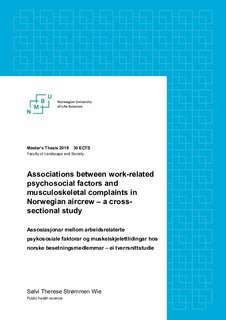| dc.contributor.advisor | Ihlebæk, Camilla | |
| dc.contributor.advisor | Aamodt, Geir | |
| dc.contributor.advisor | Omholt, Mona Tønnessen | |
| dc.contributor.author | Wie, Sølvi Therese Strømmen | |
| dc.date.accessioned | 2018-11-23T12:21:30Z | |
| dc.date.available | 2018-11-23T12:21:30Z | |
| dc.date.issued | 2018 | |
| dc.identifier.uri | http://hdl.handle.net/11250/2574580 | |
| dc.description.abstract | Background. Aircrew have high-risk occupations for musculoskeletal complaints (MSC), still there is limited recent knowledge of the prevalence of MSC in this occupational group. Furthermore, there is scarce knowledge about the relationship between work-related psychosocial factors and MSC in aircrew, and the potential differences between cabin crew and cockpit crew. The aim of this study was therefore to investigate differences in MSC and work-related psychosocial factors, and the associations between them, in the two groups.
Method. In a cross-sectional study conducted in 2013, 843 aircrew members in the three major airline companies in Norway completed a questionnaire covering MSC in eight body sites (The Subjective Health Complaints Inventory), and eighteen workrelated psychosocial risk factors on individual, organizational and task level (QPS Nordic 34+). The associations between work-related psychosocial factors and MSC were investigated by multiple logistic regression analyses for cockpit and cabin crew separately.
Results. Cabin crew reported a higher prevalence of all MSC, except for low back pain. The complaints reported most frequently in both occupational groups were low back pain, headache, neck pain and shoulder pain. Cabin crew reported higher levels of low positive challenge at work, low role clarity, high role conflict, low control of decisions, and high inequality, while cockpit crew reported higher levels of high learning demands, low control of work pacing, low support from coworkers, low support from friends, low perception of group work, and low innovative climate. The risk of reporting a high level of musculoskeletal complaints was significantly increased by reporting high quantitative demands, low social climate and high inequality in cockpit crew, and high role conflict and low control of decisions in cabin crew.
Conclusions. The prevalence of musculoskeletal complaints was higher in cabin crew compared to cockpit crew. Musculoskeletal complaints were associated with different work-related psychosocial factors in cabin crew and cockpit crew, indicating that preventing musculoskeletal complaints in the two occupational groups requires different interventions. However, longitudinal studies on specific work-related psychosocial factors is needed to confirm the findings. | nb_NO |
| dc.description.abstract | Bakgrunn. Til tross for at besetningsmedlemmar har yrke med høg risiko for muskelskjelettlidingar (MSL), er det begrensa kunnskap om forekomsten av MSL i denne yrkesgruppa. Vidare er det lite kunnskap om høvet mellom arbeidsrelaterte psykososiale faktorar og MSL hos besetningsmedlemmar, samt potensielle skilnader mellom kabin- og cockpitpersonale. Føresegna med denne studien var derfor å undersøke skilnader i MSL og arbeidsrelaterte psykososiale faktorar, samt assosiasjonane mellom dei, hos dei to yrkesgruppene.
Metode. I ei tverrsnittstudie som vart utført i 2013, fylte 843 besetningsmedlemmar tilsett i dei tre største flyselskapa i Norge ut eit spørreskjema med spørsmål om MSL på åtte stader på kroppen (The Subjective Health Complaints Inventory), og atten arbeidsrelaterte psykososiale risikofaktorar på individuelt-, organisatorisk- og oppgåvenivå (QPS Nordic 34+). Assosiasjonane mellom arbeidsrelaterte psykososiale faktorar og MSL vart utforska med logistiske regresjonsanalyser for cockpit- og kabinpersonale kvar for seg.
Resultat. Kabinpersonale rapporterte høgare førekomst av alle MSL, med unntak av korsryggsmerter. Dei hyppigast rapporterte lidingane i begge yrkesgruppene, var korsryggsmerter, hovudverk, nakkesmerter og skuldersmerter. Kabinpersonale rapporterte høgare nivå av låg positiv utfordring på jobb, låg rolleklårheit, høg rollekonflikt, låg kontroll over avgjerder og høg ulikskap, medan cockpitpersonale rapporterte høgare nivå av høge læringskrav, låg kontroll over arbeidstempo, låg støtte frå medarbeidarar, låg støtte frå vener, låg oppfatning av gruppearbeid og låg innovativt klima. Risikoen for å rapportere høgt nivå av muskelskjelettlidingar auka signifikant ved rapportering kvantitative krav, lågt sosialt klima og høg ulikskap for cockpitpersonale, og høg rollekonflikt og låg kontroll over avgjerder for kabinpersonale.
Konklusjonar. Førekomsten av muskelskjelettlidingar var høgare hos kabinpersonale enn hos cockpitpersonale. Vidare var muskelskjelettlidingar assosiert med ulike arbeidsrelaterte psykososiale faktorar hos kabinpersonale og cockpitpersonale, noko som indikerer at førebygging av muskelskjelettlidingar krev ulike intervensjonar hos dei to yrkesgruppene. Like fullt er det behov for kohortstudier av spesifikke arbeidsrelaterte psykososiale faktorar for å bekrefte resultata. | nb_NO |
| dc.language.iso | eng | nb_NO |
| dc.publisher | Norwegian University of Life Sciences, Ås | nb_NO |
| dc.rights | Attribution-NoDerivatives 4.0 Internasjonal | * |
| dc.rights.uri | http://creativecommons.org/licenses/by-nd/4.0/deed.no | * |
| dc.subject | Occupational health | nb_NO |
| dc.subject | Cabin crew | nb_NO |
| dc.subject | Flight attendants | nb_NO |
| dc.subject | Cockpit crew | nb_NO |
| dc.subject | Pilots | nb_NO |
| dc.title | Associations between work-related psychosocial factors and musculoskeletal complaints in Norwegian aircrew : a cross-sectional study | nb_NO |
| dc.title.alternative | Assosiasjonar mellom arbeidsrelaterte psykososiale faktorar og muskelskjelettlidingar hos norske besetningsmedlemmar | nb_NO |
| dc.type | Master thesis | nb_NO |
| dc.description.localcode | M-FOL | nb_NO |

